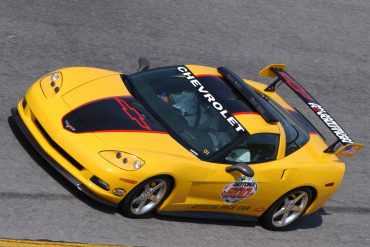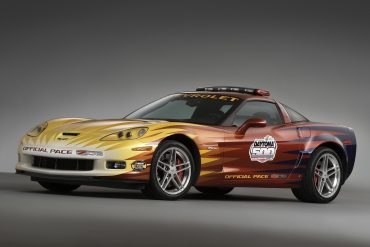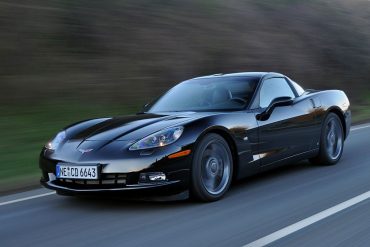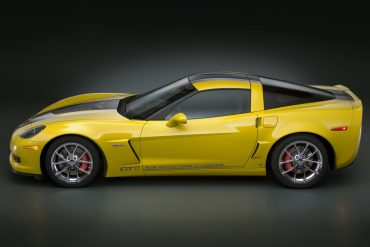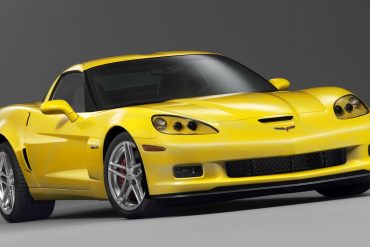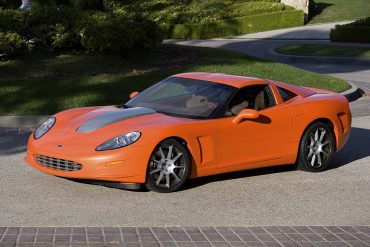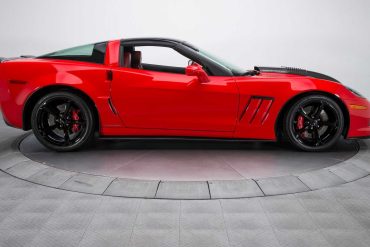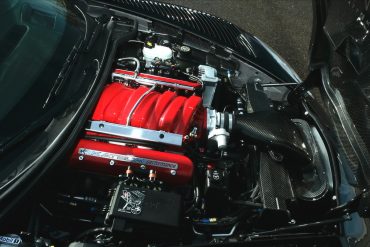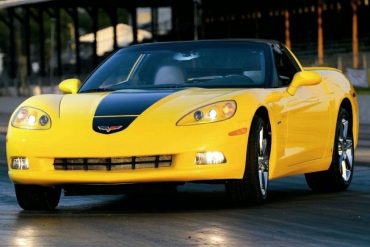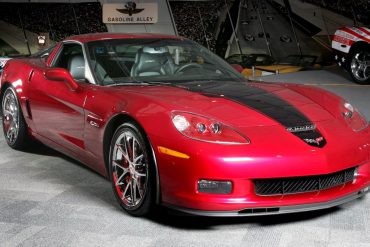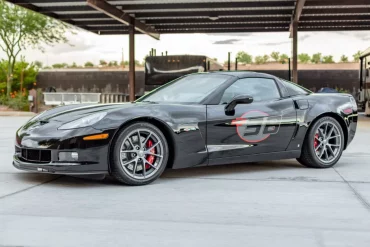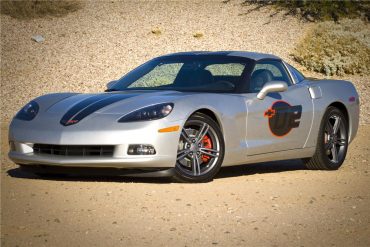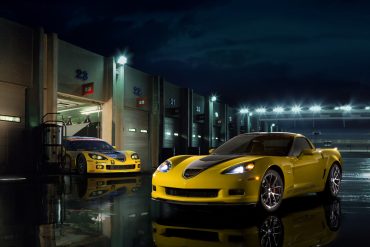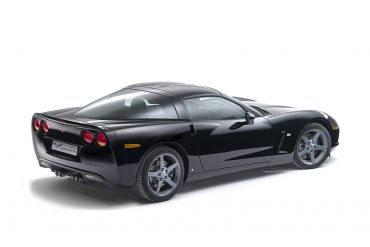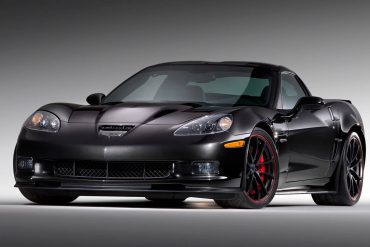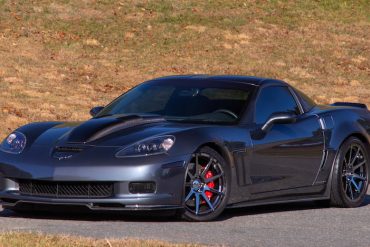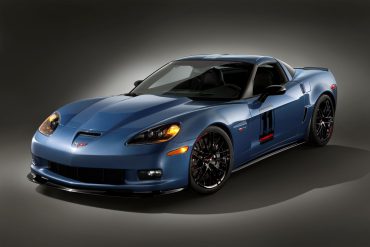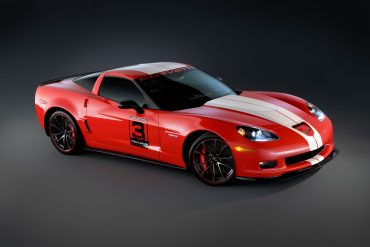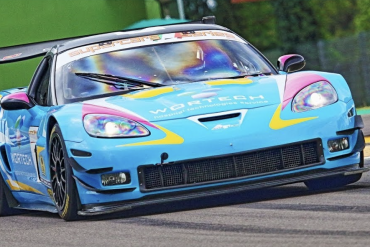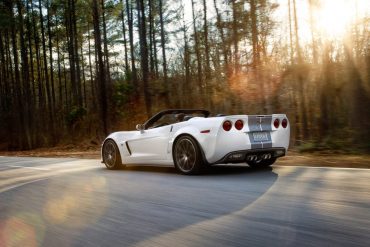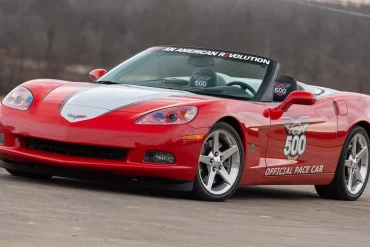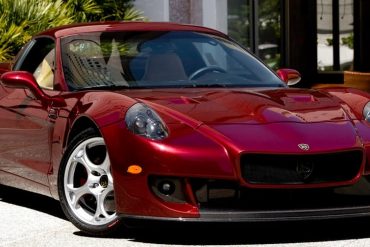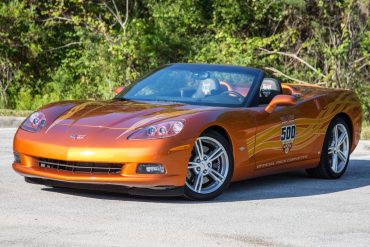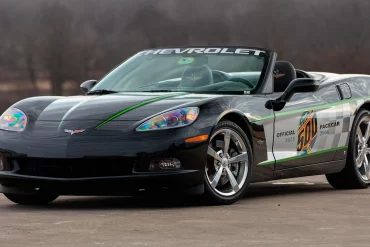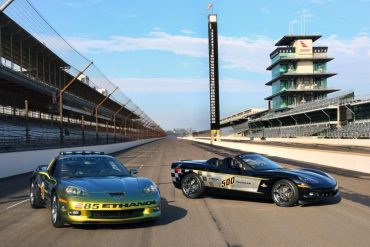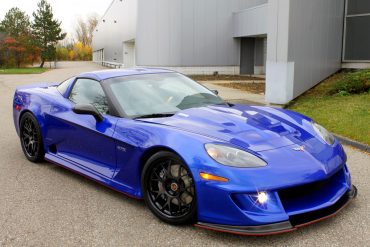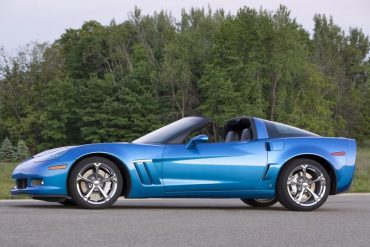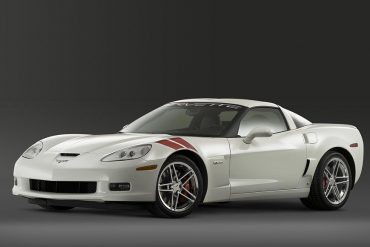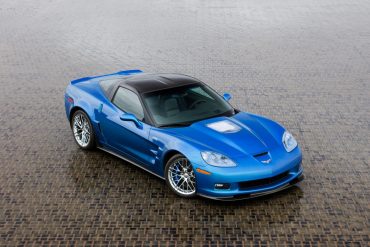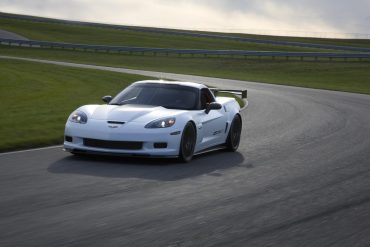In 2005, the Corvette was chosen as the official pace car of the 47th Daytona 500. The car was based on a 2005 production model Corvette and it presented an excellent opportunity for the 2005 Corvette to showcase its true capabilities. The pace car was designed to honor the heritage of the historic Corvette race cars of yesteryear. It was finished in millennium yellow with over-the-top black racing stripe that runs from the hood to the trunk lid. It is powered by a 6.0L V-8 LS2 engine with 400 horsepower.
The Corvette Z06 that served as the Daytona 500 pace car was mechanically identical to those available at Chevrolet dealerships. It was the fastest vehicle ever offered by Chevrolet and General Motors. With 505 horsepower (377 kw) and 470 lb.-ft. of torque (637 Nm) from its 7.0L all-aluminum, racing-inspired engine, the Corvette Z06 leaps from 0-60 mph in 3.7 seconds and has a top speed of 198 mph. The Corvette Z06 Daytona 500 wears a unique paint scheme.
In addition to the limited-edition Corvette Victory Edition, a second special version of our favorite all-American sports car was introduced in spring, the Corvette Competition. This model, built in limited numbers on the basis of the C6 Corvette, bears strong links to motor sport too, in which the Corvette has proven highly successful. The Corvette Competition was competitively priced and one heck of a package.
Chevrolet introduced the limited production Corvette GT1 Championship Edition at Sebring International Raceway. The GT1 Championship Edition (Regular Production Option GT1) commemorates the success of Corvette Racing and the Corvette C6R:
The Z06 arrived for the 2006 model year as a homologation vehicle in the third quarter of 2005 and is the lightest of all Corvette models. The Z06 was equipped with the largest-displacement small-block engine ever produced, a new 7,011 cc (7.0 L; 427.8 cu in) V8 engine codenamed the LS7. The engine has a power output of 505 hp and 470 lb⋅ft.
The Callaway C16 was Callaway’s 16th major automotive project. It was a limited production, bespoke automobile, built to order, by what the Press called “the best specialist engineers in the business”. These cars are seriously fast, beautiful, and exclusive. The C16 was a direct competitor for the Porsche GT3, the Lamborghini Murcielago, the Ferrari 599 GTB. It was both faster and more capable than its competitors, at less cost.
The 2005-2013 Callaway Corvette was a specialist version of the C6 Corvette, built by Callaway Cars expert craftsmen and sold through selected Callaway/Chevrolet dealers. The 17th “C-Project” undertaken by Callaway first produced naturally-aspirated SuperNatural™ 450, 461, 490 (6.0L) and 550 (6.8L & 7.0L) horsepower Callaway Corvettes. In February 2006, Callaway returned to its positive manifold pressure roots, introducing Callaway “SuperCharged” Corvettes.
In 2006, the company behind the Corvette C6.R pulled out all the stops and developed a Corvette (based on a Z06 donor car and a lot of amazing engineering) that featured an unprecedented amount of horsepower and torque under its hood while packing ultimate luxury inside its ultra-wide carbon-fiber body. The car, which was revealed at the SEMA show in 2007, was called the C6RS Corvette.
Built exclusively for Hertz Rental Car, the Corvette ZHZ coupe was first introduced in 2008 as part of Hertz’s “Fun Collection.” These Corvettes were part of a larger group of rental vehicles made up of cars like the Ford Mustang, the Nissan 350Z and the Shelby GT-H. The intent behind these rental cars was simple - provide consumers with an opportunity to rent (at a rate commensurate with the car's performance) a well-equipped sports car for a day, a weekend or even longer.
The 427 Limited Edition option, code Q8A and Z44, was limited to 505 examples globally with 427 destined for North American customers. As a retirement gift to Wil Cooksey, the Corvette plant manager from 1993 to 2008, he chose the color scheme and hand signed and numbered the underside of the armrest console lids on all 505 examples in which this example is #6. As part of the package, the seats and the floor mats have “427” embroidery, and the center-console trim plate is color matched.
There were only 20 Z06s produced with the Competition Sport package for worldwide purchase. This Z06 is powered by a 7.0-liter LS7 V8 engine producing 505hp and 424 ft/lbs torque, paired to the 6-speed manual transmission. The LS7 engine can propel this Z06 from 0-60 mph in 3.6 seconds. This Z06 CSR features leather interior, articulated sport seats, premium audio system, CD player and heads-up display.
Chevrolet introduced the limited production Competition Sport package for both the 2009 Corvette coupe and the Z06, bringing the look of Corvette's racing team to their non-ZR1 offerings, if not quite the performance. Both the Z06 and Coupe 1LT Vettes ordered with the Competition Sport package will get a track focus, which includes...
Chevrolet introduced the limited production Corvette GT1 Championship Edition at Sebring International Raceway. The GT1 Championship Edition (Regular Production Option GT1) commemorates the success of Corvette Racing and the Corvette C6R.
To celebrate the success of the Corvette Racing program, especially at the prestigious 24 Hours of Le Mans race, Chevrolet made the decision to manufacture a limited number of special-edition Corvettes that would be sold exclusively in Europe. This special-edition car was limited to just 250 units and marketed to European consumers as the Victory Edition Corvette.
The Centennial Edition came finished exclusively in a Carbon Flash Metallic finish with satin-black graphics. Special badging graphics signifying Chevrolet’s racing history, including an image of Louis Chevrolet on the B-pillars, were added as accents to the cars finish. The wheels were also finished in satin black. All models also received red brake calipers. The exterior color scheme of the Centennial Edition Corvette is reinforced inside the car.
To commemorate its quarter-century milestone, Callaway Cars collaborated with Chevrolet, arranging a production run of 25 uniquely prepared 2012 Corvette Grand Sport coupes and convertibles. General Motors supplied special parts and procedures on the Bowling Green production line to facilitate final assembly at Callaway factories. Then, the performance and identity components are installed by Callaway. The 25th Anniversary Edition produced 620 bhp and 555 lb-ft of torque.
The Z06 Carbon was created to celebrate the 50th anniversary of the first appearance of the Corvette at the 24 Hours of Le Mans when John Fitch and Briggs Cunningham won their class and finished eighth overall. The Carbon edition is essentially a Z06 with a ZR1 chassis and some of the carbon skin. With only 500 examples made, this is one rare and special looking Vette. The limited edition is distinguished by an aggressive look and black accents, reminiscent of the Porsche 911 GTS range.
This special edition Corvette comes with a ZO6 Performance Package, Magnetic Selective Ride Control, CFZ carbon fiber package with splitter and rocker moldings, carbon fiber raised hood, black headlamp housings and mirrors, red brake calipers, ebony interior with red stitching, suede-trimmed steering wheel, shift knob, parking brake handle and armrests with red stitching, centennial-model seats, racing pedal package, and racing-style graphics.
During the summer of 2005, a decision was made to transform selected Z06 road cars into a new breed of racer to compete in the world's top GT3 championships. The first series to introduce this new GT3 class was the SRO and FIA's GT3 Championship. Based on their racetrack test results, Team Carsport saw instant potential in the car. Hezemans contracted Callaway Competition in conjunction with Koos Pettinga, manager at Corvette Europe, to convert the street Z06 into a Z06R GT3.
The 2013 Corvette 427 Convertible served double-duty as a commemorative edition model. While it marked the departure of the sixth-generation Corvette. The real selling-point was the powerplant at the heart of the car - a 427-cubic-inch (7.0L) LS7 engine, the same engine used in the C6 Corvette Z06. Rated at 505 horsepower (377kW) and 470lb.-ft of torque (637 Nm), this 427 was the most powerful engine GM had ever installed in a production Corvette convertible to date.
The 2005 Corvette Pace Car paced at the 89th Annual Indianapolis 500 on May 29, 2005. It was driven by Retired Army General and former Secretary of State Colin Powell. There were three Pace Cars produced. Eight Track/Festival convertibles painted Victory Red Corvette were used on race day. These Track/Festival Pace Cars did not have the center silver stripe, logo-embroidered headrest, and graphics that were on the actual pace car. There were two replica pace cars produced.
As early as the late 1990's, San Francisco based coach-builder SV Motor Company envisioned a car that took the raw performance of a Corvette and refined it with a touch of Italian flair. Their vision was to infuse many of the design elements found in the Alfa Romeo 8C Competizione (from which the SV 9 clearly drew its inspiration, as well as its name) with a 2009 Chevy Corvette.
One special-edition Corvette was introduced in 2007 was based on the Corvette Pace Car that was used at the 91st running of the Indianapolis 500 driven by actor/racer Patrick Dempsey. The significance of this car was the fact that GM had not produced a pace car replica since the 1998 model year, even though the Corvette had paced the prestigious event a bunch of times since then.
Total Production for the 2008 Indy Pace Car replicas sold to the public was 500. The first replica rolled off the production line approximately March 4th, and the last was June 6th. There were 61 Corvettes built in early March, however only 60 cars shipped to the Indianapolis Motor Speedway to be used as rack” and “festival committee" vehicles which were distributed to their lucky drivers on April 9th and in use thru May 31st.
Known for their charismatic designs and superior performance, the pack-leading Pace Cars share a special place in Indianapolis 500 lore. History was made at the 2008 Indianapolis 500 when a pair of distinctive yet highly differentiated Corvette models served as the Official Pace Cars — one highlighting a commitment to fuel solutions and the other marking 30 years of Corvette's Pace Car heritage.
Based on the Corvette Z06, this new GTR also represents a collaboration between Specter Werkes and Lingenfelter Performance Engineering, with a Lingenfelter twin-turbo system powering the car – and pumping its 7.0-liter LS7 engine to 800 horsepower. Featuring dramatic bodywork and carbon fiber details, the GTR blends racing-inspired design cues with uncompromising luxury and performance.
The 2010 Grand Sport Corvette was introduced to the world at the 12th annual C5/C6 Corvette Birthday Bash, which was (and is) held at the National Corvette Museum in Bowling Green, Kentucky. During its unveiling, it was announced that the new Grand Sport would be offered as either a coupe or a convertible, and it would feature an appealing combination of the LS3 power plant fused with the Z06 Corvette’s wide track chassis and styling features.
The Ron Fellows ALMS GT1 Champion Edition Corvette was introduced as part of the 2007 Corvette line-up. To commemorate Mr. Fellows long and successful career with the Corvette Racing program, Chevrolet introduced the Ron Fellows Championship Edition Z06 Corvette as part of their 2007 model line-up. It was released as a commemorative model to celebrate one of GM's winning-est drivers, but did little to impress enthusiasts or collectors when first introduced.
The ZR-1 returned with the 1990 Corvette lineup after an eighteen year hiatus. This time, it featured a special LT5 engine that had been developed by Lotus (which, at the time, had been a subsidiary of General Motors.) The LT5 engine featured an all-aluminum block, four overhead camshafts, and 32 valves. It also featured an air management system which enabled the car to maintain proper operation while closing off half of its fuel injection system.
The 2011 Chevrolet Corvette Z06X Track Car Concept was designed to suggest new components and a new idea for transforming a production Corvette into a serious and closed-course track car. This track car concept was developed and produced by Chevrolet in partnership with Pratt and Miller, the partners in Corvette Racing in the American LeMans Series. The competition-oriented modifications of the concept include a polycarbonate rear window, roll cage, safety harness, racing seat.


